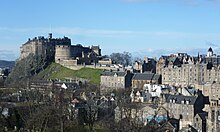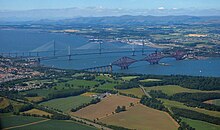The Edinburgh Portal
Welcome! — Fàilte! — Walcome!
Edinburgh (/ˈɛdɪnbərə/ ⓘ Scots: [ˈɛdɪnbʌrə]; Scottish Gaelic: Dùn Èideann [ˌt̪un ˈeːtʲən̪ˠ]) is the capital city of Scotland and one of its 32 council areas. The city is located in south-east Scotland, and is bounded to the north by the Firth of Forth estuary and to the south by the Pentland Hills. Edinburgh had a population of 506,520 in mid-2020, making it the second-most populous city in Scotland and the seventh-most populous in the United Kingdom. The wider metropolitan area has a population of 912,490
Recognised as the capital of Scotland since at least the 15th century, Edinburgh is the seat of the Scottish Government, the Scottish Parliament, the highest courts in Scotland, and the Palace of Holyroodhouse, the official residence of the British monarch in Scotland. It is also the annual venue of the General Assembly of the Church of Scotland. The city has long been a centre of education, particularly in the fields of medicine, Scottish law, literature, philosophy, the sciences and engineering. The University of Edinburgh, founded in 1582 and now one of three in the city, is considered one of the best research institutions in the world. It is the second-largest financial centre in the United Kingdom, the fourth largest in Europe, and the thirteenth largest internationally.
The city is a cultural centre, and is the home of institutions including the National Museum of Scotland, the National Library of Scotland and the Scottish National Gallery. The city is also known for the Edinburgh International Festival and the Fringe, the latter being the world's largest annual international arts festival. Historic sites in Edinburgh include Edinburgh Castle, the Palace of Holyroodhouse, the churches of St. Giles, Greyfriars and the Canongate, and the extensive Georgian New Town built in the 18th/19th centuries. Edinburgh's Old Town and New Town together are listed as a UNESCO World Heritage Site, which has been managed by Edinburgh World Heritage since 1999. The city's historical and cultural attractions have made it the UK's second-most visited tourist destination, attracting 4.9 million visits, including 2.4 million from overseas in 2018. (Full article...)
Selected location article
Edinburgh Castle is a historic castle in Edinburgh, Scotland. It stands on Castle Rock, which has been occupied by humans since at least the Iron Age. There has been a royal castle on the rock since at least the reign of Malcolm III in the 11th century, and the castle continued to be a royal residence until 1633. From the 15th century, the castle's residential role declined, and by the 17th century it was principally used as a military garrison. Its importance as a part of Scotland's national heritage was recognised increasingly from the early 19th century onwards, and various restoration programmes have been carried out over the past century and a half.
Edinburgh Castle has played a prominent role in Scottish history, and has served variously as a royal residence, an arsenal, a treasury, a national archive, a mint, a prison, a military fortress, and the home of the Honours of Scotland - the Scottish regalia. As one of the most important strongholds in the Kingdom of Scotland, the castle was involved in many historical conflicts from the Wars of Scottish Independence in the 14th century to the Jacobite rising of 1745. Research undertaken in 2014 identified 26 sieges in its 1,100-year history, giving it a claim to having been "the most besieged place in Great Britain and one of the most attacked in the world". Few of the present buildings pre-date the Lang Siege of 1573, when the medieval defences were largely destroyed by artillery bombardment. The most notable exceptions are St Margaret's Chapel from the early 12th century, which is regarded as the oldest building in Edinburgh, the Royal Palace, and the early 16th-century Great Hall. The castle is the site of the Scottish National War Memorial and the National War Museum. The British Army is still responsible for some parts of the castle, although its presence is now largely ceremonial and administrative. The castle is the regimental headquarters of the Royal Regiment of Scotland and the Royal Scots Dragoon Guards and houses their regimental museums, along with that of the Royal Scots. (Full article...)
Selected images
Selected transportation article
The Union Canal was opened in 1822 and provides an inland waterway link from Edinburgh to Falkirk and from there to Glasgow via the Forth and Clyde Canal. It is currently owned by the public corporation Scottish Canals and chiefly used for leisure purposes. (Full article...)
Selected area article

The Calders is a residential neighbourhood in Edinburgh, Scotland – not to be confused with the Calders of West Lothian aka West Calder, Mid Calder and East Calder, three separate villages. It is sometimes considered to be part of Wester Hailes or Sighthill, larger developments to its south and east respectively. From 2007 to 2017, it fell within the Sighthill/Gorgie multi-member ward of the City of Edinburgh Council administration along with Sighthill, but following a boundary change has been in the Pentland Hills ward since then, along with Wester Hailes.
To the west of the neighbourhood is the A720 Edinburgh city bypass road, with Heriot-Watt University's main campus at Riccarton beyond. To the north, the Calders borders the A71 Calder Road, which at that point is a dual carriageway leading off the city bypass towards Gorgie and the city centre; on the other side of the A71 is the large Bankhead industrial estate. The Union Canal passes through the area, marking its western and southern boundaries. Pedestrian underpasses connect the Calders to Bankhead under the A71, and to Sighthill under the B701 Wester Hailes Road, also a dual carriageway. The presence of the three main roads and canal surrounding the area on all sides gives it a somewhat isolated character, and a roughly square territory. (Full article...)
Selected environment article
The Firth of Forth (Scottish Gaelic: Linne Foirthe) is the estuary, or firth, of several Scottish rivers including the River Forth. It meets the North Sea with Fife on the north coast and Lothian on the south. (Full article...)
Did you know?
- ... that George Parks was president of the Royal College of Surgeons in Ireland and his son Rowan Parks became president of the Royal College of Surgeons of Edinburgh?
Selected arts article
Sir Walter Scott, 1st Baronet FRSE FSAScot (15 August 1771 – 21 September 1832), was a Scottish novelist, poet and historian. Many of his works remain classics of European and Scottish literature, notably the novels Ivanhoe (1819), Rob Roy (1817), Waverley (1814), Old Mortality (1816), The Heart of Mid-Lothian (1818), and The Bride of Lammermoor (1819), along with the narrative poems Marmion (1808) and The Lady of the Lake (1810). He had a major impact on European and American literature.
As an advocate, judge, and legal administrator by profession, he combined writing and editing with his daily work as Clerk of Session and Sheriff-Depute of Selkirkshire. He was prominent in Edinburgh's Tory establishment, active in the Highland Society, long time a president of the Royal Society of Edinburgh (1820–1832), and a vice president of the Society of Antiquaries of Scotland (1827–1829). His knowledge of history and literary facility equipped him to establish the historical novel genre as an exemplar of European Romanticism. He became a baronet of Abbotsford in the County of Roxburgh, Scotland, on 22 April 1820; the title became extinct upon his son's death in 1847. (Full article...)
Selected education article
List of schools in Edinburgh is a list of schools in the City of Edinburgh council area of Scotland. It lists schools both within Edinburgh itself, and in outlying villages within the local government boundary. (Full article...)
Selected sports article
The Edinburgh derby is an informal title given to any football match played between Scottish clubs Heart of Midlothian (Hearts) and Hibernian (Hibs), the two oldest professional clubs based in Edinburgh, Scotland. The two clubs have a fierce rivalry that dates back to the clubs being founded in the mid-1870s, which makes it one of the longest running rivalries in world football. The first match between the clubs was played on the Meadows on Christmas Day 1875.
The matches are normally played at either Easter Road or Tynecastle. It has been regularly played in the top level of the Scottish football league system, although derbies were played in the second tier during the 2014–15 season. The teams sometimes also play against one another in cup tournaments, such as the Scottish Cup and Scottish League Cup. The clubs have met twice in Scottish Cup finals, in 1896 and 2012, both of which were won by Hearts. (Full article...)
Selected religion article
The Archdiocese of Saint Andrews & Edinburgh (Latin: Archidioecesis Sancti Andreae et Edimburgensis) is an archdiocese of the Latin Church of the Catholic Church in Scotland. It is the metropolitan see of the province of Saint Andrews and Edinburgh, consisting of the additional suffragan sees of Aberdeen, Argyll and the Isles, Dunkeld, and Galloway. The archdiocese is led by Archbishop Leo Cushley, and its cathedral is St Mary's Cathedral, Edinburgh. (Full article...)
Related portals
In the news
No recent news
Associated Wikimedia
The following Wikimedia Foundation sister projects provide more on this subject:
-
 Commons
Commons
Free media repository -
 Wikibooks
Wikibooks
Free textbooks and manuals -
 Wikidata
Wikidata
Free knowledge base -
 Wikinews
Wikinews
Free-content news -
 Wikiquote
Wikiquote
Collection of quotations -
 Wikisource
Wikisource
Free-content library -
 Wikiversity
Wikiversity
Free learning tools -
 Wikivoyage
Wikivoyage
Free travel guide -
 Wiktionary
Wiktionary
Dictionary and thesaurus
-

-

-

-

-
Random portal
Purge server cache















































